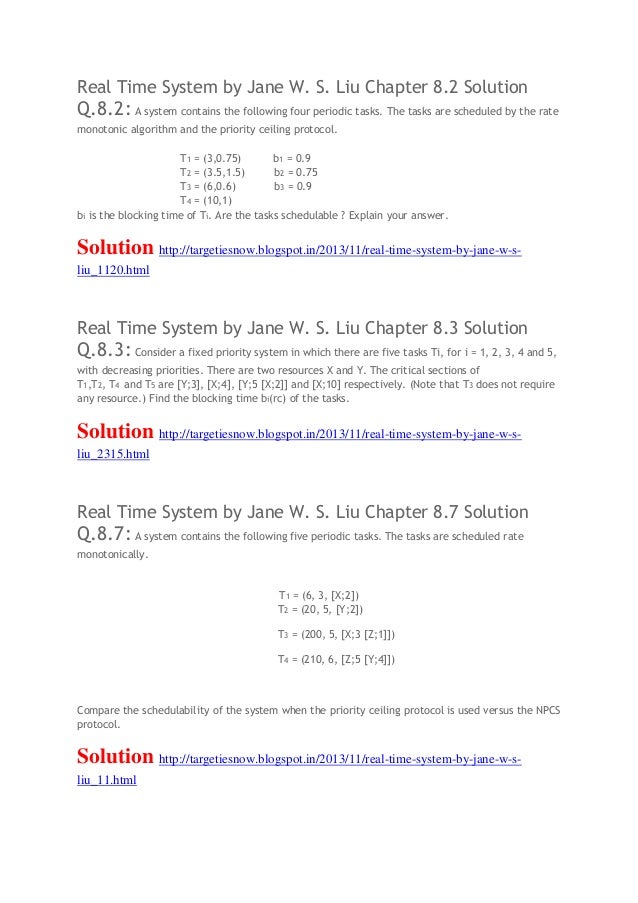Gleb sedih nedomerok 2 fb2. TypicalReal-TimeApplications From its title, you can see that this book is about real-time (computing, communication, and information) systems. Rather than pausing here to define the term precisely, which we will do in Chapter 2, let us just say for now that a real-time system is required to complete its work and deliver its services on a.
It covers techniques for scheduling, resource access control, and validation that are, or are likely to be, widely used in real time computing and communication systems. Each algorithm, protocol, or mechanism is defined by pseudo code or simple rules that can serve as a starting point of implementation. With few exceptio ns, each scheduling algorithm is accompanied that your application will meet its real time requirement when scheduling according to the algorithm.
My favourite creature was the little rain drop creatures. Prehistoric shark game. I liked the different types of hostile creatures and your army because they all looked different depending on what type of person/creature they were.
Here, in next successive posts, I am going to post solutions for the same Text-book (Real Time System by Jane W. If you find any difficulty or wants to suggest anything, feel free to comment.:). Because sporadic jobs may have varying release times and execution times, the periodic task model may b e too inaccurate and can lead to undue under utilization of the processor even when the inter release times of jobs are bounded from below and their executions are bounded from above. As an example, suppose we have a stream of sporadic jobs whose inter release times are uniformly distributed from 9 to 11. Their execution times are uniformly distributed from 1 to 3. What are the parameters of the periodic task if we were to use such a task to model the stream?
This article includes a, but its sources remain unclear because it has insufficient. Please help to this article by more precise citations.
( April 2014) () In, real-time computing ( RTC), or reactive computing describes and systems subject to a 'real-time constraint', for example from to. Real-time programs must guarantee response within specified time constraints, often referred to as 'deadlines'. The correctness of these types of systems depends on their temporal aspects as well as their functional aspects.
Real-time responses are often understood to be in the order of milliseconds, and sometimes microseconds. A system not specified as operating in real time cannot usually guarantee a response within any timeframe, although typical or expected response times may be given. A real-time system has been described as one which 'controls an environment by receiving data, processing them, and returning the results sufficiently quickly to affect the environment at that time'. The term 'real-time' is also used in to mean that the simulation's clock runs at the same speed as a real clock, and in and to mean 'without significant delay'. Real-time software may use one or more of the following:,, and real-time networks, each of which provide essential frameworks on which to build a real-time software application. Systems used for many applications must be real-time, such as for control of aircraft, or on a vehicle, which must produce maximum deceleration but intermittently stop braking to prevent skidding. Real-time processing fails if not completed within a specified deadline relative to an event; deadlines must always be met, regardless of.
Contents • • • • • • • • • • • History [ ] The term real-time derives from its use in early, in which a real-world process is simulated at a rate that matched that of the real process (now called to avoid ambiguity)., most often, were capable of simulating at a much faster pace than real-time, a situation that could be just as dangerous as a slow simulation if it were not also recognized and accounted for. Minicomputers, particularly in the 1970s onwards, when built into dedicated such as DOG scanners, increased the need for low-latency priority-driven responses to important interactions with incoming data and so operating systems such as 's and RTOS with as well as 's date from this era. Background-foreground scheduling allowed low priority tasks CPU time when no foreground task needed to execute, and gave absolute priority within the foreground to threads/tasks with the highest priority. Real-time operating systems would also be used for multiuser duties. For example, could run in the foreground or background of RDOG (and would introduce additional elements to the scheduling algorithm to make it more appropriate for people interacting via.

Once when the (used in the and ), and later when the (used in the,, and ) were popular, anybody could use their home computer as a real-time system. The possibility to deactivate other interrupts allowed for hard-coded loops with defined timing, and the low allowed the implementation of a real-time operating system, giving the user interface and the disk drives lower priority than the real-time thread. Compared to these the of the Intel CPUs (8086.80586) generates a very large latency and the Windows operating system is neither a real-time operating system nor does it allow a program to take over the CPU completely and use its own, without using native machine language and thus surpassing all interrupting Windows code. However, several coding libraries exist which offer real time capabilities in a high level language on a variety of operating systems, for example. The and subsequent family members (68010, 68020 etc.) also became popular with manufacturers of industrial control systems. This application area is one in which real-time control offers genuine advantages in terms of process performance and safety.